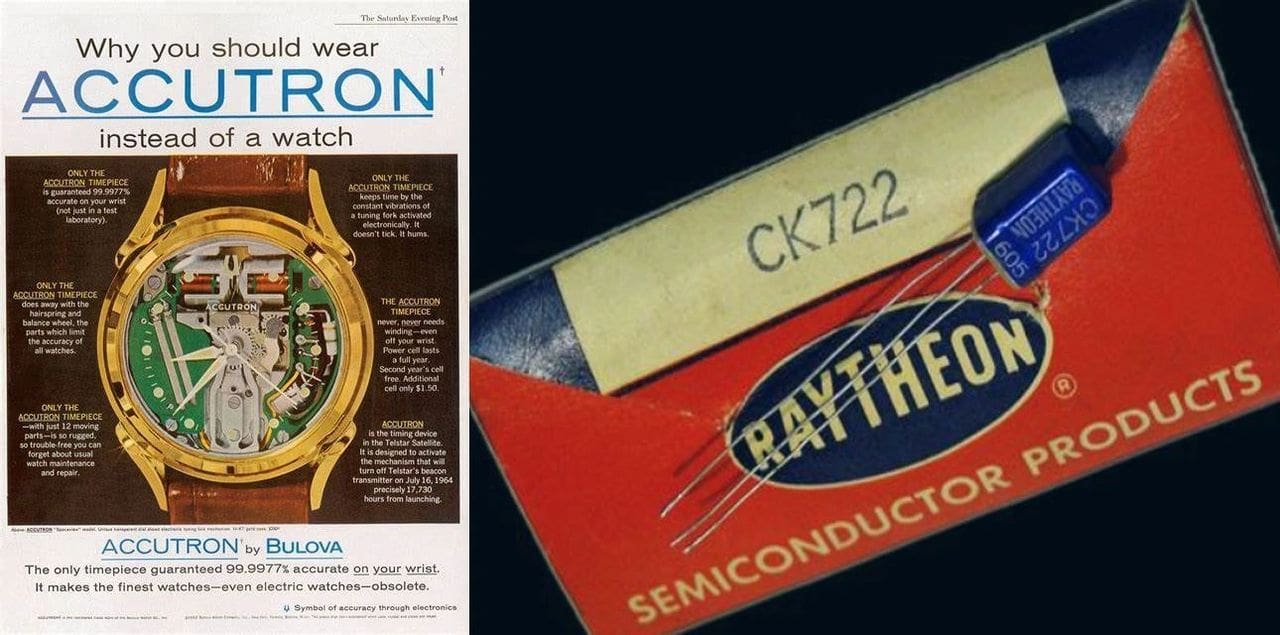
Accutron and the transistor…
When he developed the Accutron, Max Hetzel used a Raytheon CK718 transistor for his first prototype and Raytheon CK722 transistors for the remaining 7. The CK722 was the first commercial transistor. Mr. Hetzel produced a total of 8 prototype movements which served as models for William Bennett, a Bulova engineer, to manufacture commercially-available Accutron wristwatches.
Beginning in 1953, Max Hetzel, while employed by Bulova, began constructing his prototype Accutron, which would later become the world’s first commercially-available “electric” wristwatch. This differed from Elgin and Hamilton’s earlier attempts at a battery-powered wristwatch because it, unlike the Elgin and Hamilton calibers, did away with hairspring escapements and relied solely on battery power.
The first transistorized consumer product in the US was a $229.50 hearing aid from Sonotone in 1952.
The first transistor radio available to U. S. consumers, the Regency TR-1, hit US stores in October 1954 at a price of $49.95. Developed as a joint venture between Texas Instruments (which supplied its four germanium junction transistors) and the Regency Division of Industrial Development Engineering Associates, it generated sales of over 100,000 units and introduced the word “transistor” into the public lexicon.
The first low-cost junction transistor available to the general public was the CK722, a PNP germanium small signal unit introduced by Raytheon in early 1953 for $7.60 each. In the 1950s and 1960s, hundreds of hobbyist electronics projects based around the CK722 transistor were published in popular books and magazines.[51][52] Raytheon also participated in expanding the role of the CK722 as a hobbyist electronics device by publishing “Transistor Applications” and “Transistor Applications- Volume 2” during the mid-1950s.
Due to their initially high cost compared with vacuum tubes, transistors found their earliest consumer applications in portable devices such as hearing aids and radios, where small size and low power consumption were paramount.
“The invention of the transistor was probably the most important invention in the 20th century,” said Risto Puhakka, president of VLSI Research Inc. “It has changed society. Look at transportation, computers, government, finance, manufacturing … it’s affected them all. Look at the change in the productivity of the whole economy. It’s probably doubled from what it would have been without transistors.”
Before transistors, vacuum tubes were turned on or off to represent zeros and ones. The tube would be turned off for a zero, and on for a one. It wasn’t a very efficient technology, and [it] required a lot of tubes and bulbs and heat to do basic mathematically calculations. In fact, the term bug was coined when moths or other insects would light on the tubes and blow them out, according to Mike Feibus, an analyst at TechKnowledge Strategies Inc. By modern standards, tube-based computers were slow and enormously bulky. There was no need for a shoulder bag or a Wi-Fi connection in a hotel room.
So, ultimately, first came the hearing aid, then came the radio, then came the Accutron. The Accutron did it best, though, because after 60 plus years, many of the early Accutron models are still working, whereas, I’d bet none of the hearing aids are working and very few of the earliest transistor radios are still operational.
Tags: